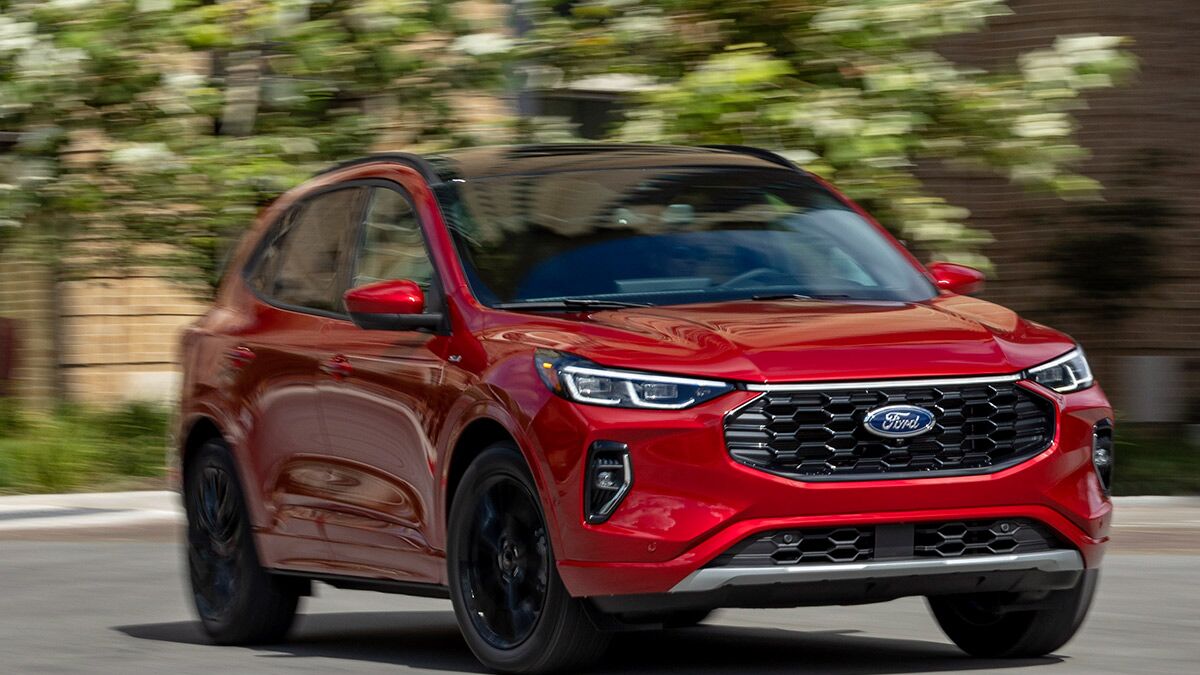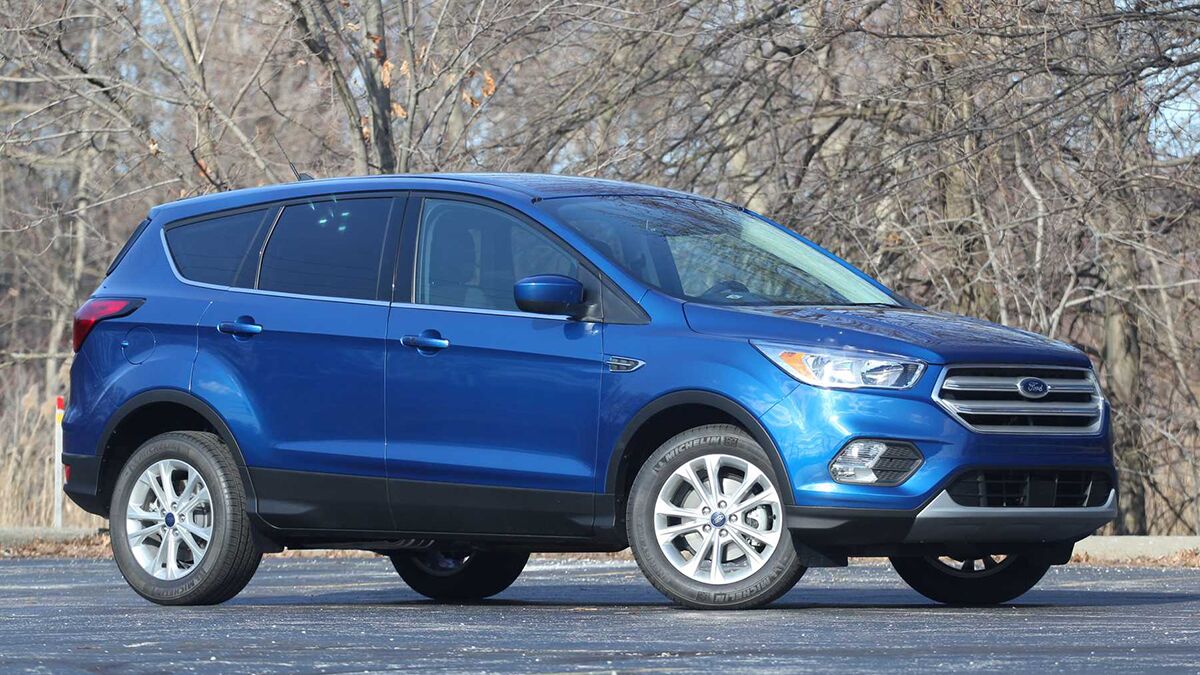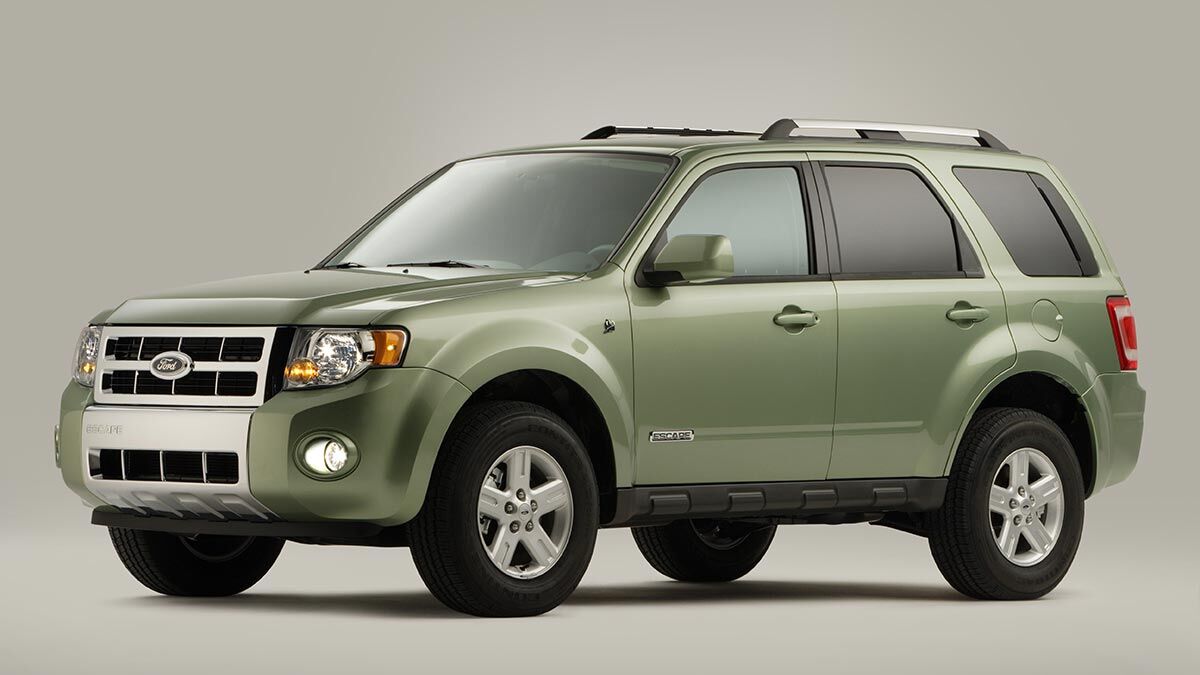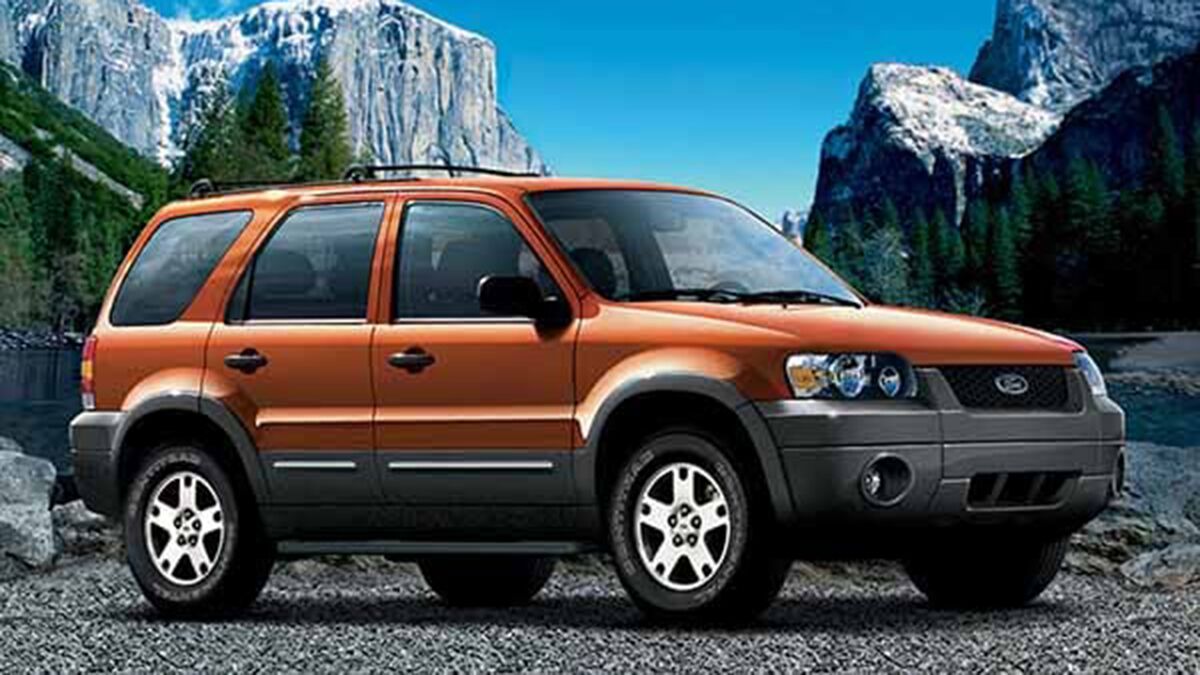Used Ford Escape Quick Facts
- The best years for buying a used Ford Escape are 2023 and later or 2010-2012, if you don’t mind something older.
- The Escape comes in gas, hybrid, and plug-in hybrid models.
- The 2005 Escape was the first hybrid SUV sold in America.
Depending on the model and year, a used Ford Escape can be a blessing or a curse. Early versions are praised for their reliability, fuel economy, and capability. However, later models, especially the third-generation, have several issues that raise a few red flags, particularly those with the 1.6-liter EcoBoost engine. As compact SUVs go, the Ford Escape has much to offer, including hybrid and plug-in hybrid powertrains, a series of powerful turbocharged engine options, and some cool high-tech features absent from the competition. Let’s dive a little deeper and see which years are the safest bet.
- What Is the Best Model-Year Used Ford Escape?
- Ford Escape by Generation: Which Should You Buy?
- Is the Ford Escape a Good SUV?
- Does the Ford Escape Have a Hybrid Option?
- How Much Can the Ford Escape Tow?
- What Are the Most Reliable Years for the Ford Escape?
- What Are the Worst Years for the Ford Escape?
What Is the Best Model-Year Used Ford Escape?
For the fourth generation, we’d go with a 2023 or later. The 2015 and newer models are best for the third generation, preferably with either the 2.5-liter or 2.0-liter EcoBoost. The second generation is pretty reliable for all but the 2008-2009 model years.
See used Ford Escape SUVs near you.
Ford Escape by Generation: Which Should You Buy?
Fourth Generation: 2020-Current

The fourth-generation, 2020-to-current Ford Escape is the best choice if you’re looking for a low-mileage, late-model Escape. Redesigned in 2020, the Escape offers more interior room and technology than the third generation and has a better reliability track record. In this generation, you’ll find gasoline, hybrid, and plug-in hybrid electric vehicle (PHEV) powertrain choices. All but the PHEV offer the option of all-wheel drive (AWD).
The S, SE, and SEL trims feature an 181-horsepower 1.5-liter 3-cylinder turbocharged EcoBoost engine. A 250-hp 2.0-liter EcoBoost turbocharged engine is optional on the SEL and standard on the Titanium, while the SE Sport Hybrid comes with a 2.5-liter gas engine and electric motor for a combined output of 200 hp. Of the three, we prefer the 2.0-liter for its power and reliability. The PHEV uses the same engine as the hybrid but with a larger battery pack and can travel up to 37 miles solely on electric power.
Standard equipment includes Ford’s Co-Pilot 360, which brings automatic emergency braking, a blind-spot monitor, rear cross-traffic detection, automatic high beams, and a rearview camera. Optional upgrades start with the SE trim and include park assist, adaptive cruise control, a panoramic sunroof, and navigation.
The Titanium trim comes with a hybrid or 2.0-liter gas engine. It adds dual-zone automatic climate control, a 110-volt outlet, leather upholstery, a power passenger seat, park assist, adaptive cruise control, navigation, and a B&O audio system.
While not a bad engine, the 1.5-liter is a bit weak for the Escape, and its fuel economy isn’t much better than the more powerful 2.0-liter.
If you’re looking at this generation, we’d steer clear of the 2020-2022 models. They suffer up to 15 recalls and numerous customer complaints, mainly concerning engine and transmission issues, glitches with the infotainment screen, and oil leaks. Opt for a 2023 or newer Escape, and you’ll get more upgrades and a better track record.
To see a complete list of recalls and customer complaints, visit the National Highway Traffic Safety Administration website.
Model-Year Changes:
2025: No significant changes.
2024: Ford shuffles the trim names, with the Active model being the new base and the ST-Line the least expensive model to offer a hybrid engine.
2023: A new trim structure includes the Sport, Active, ST-Line, ST-Line Select, Platinum, and ST-Line Elite. A new face and more standard equipment round out the changes.
2022: No significant changes.
2021: Co-Pilot 360 Plus adds adaptive cruise control, the SEL gains heated front seats, and a power liftgate is offered on more trims.
See 2020 to current Ford Escape SUVs near you.
Third Generation: 2013-2019

The third-generation Escape is a significant departure from the first and second generations. It jettisons the boxy, truck-like styling for a sleeker, more sporty look. It also dumps the proven V6 and hybrid in favor of a series of 4-cylinder engines.
The standard 2.5-liter 4-cylinder carries over from the previous generation and is one of the least problematic engines in the lineup. Next is a 1.6-liter EcoBoost 4-cylinder turbo that we would avoid at all costs. Finally, the 2.0-liter EcoBoost 4-cylinder turbo provides an impressive 240 hp, more than just about any competitor.
This generation also introduces some high-end features uncommon in the class, such as an automatic parallel parking assistant, a panoramic moonroof, and a foot-activated power liftgate. It’s also the first generation to see advanced driver aids like adaptive cruise control and automatic emergency braking show up on select packages and trims.
Unfortunately, this generation is plagued with issues spread across its run, with some years being better than others, depending on the engine and transmission choices.
The 2013 and 2014 models are the most problematic, with issues related to multiple recalls, failing transmissions, overheating engines, and blown head gaskets.
If you want a better idea of why we’re so down on the early models with the 1.6-liter, read on.
Here’s a list of recalls just for the 2013 model year:
- A possible misalignment between the exterior door handle and the door’s outer panel makes it difficult to close.
- A possible software problem that could delay the deployment of the side curtain airbags.
- A possible substandard weld in the front seatback assemblies.
- Vehicles with the 1.6-liter engine that may have had a fuel line improperly reinstalled after work done for a previous recall.
- Vehicles with the 1.6-liter engine, due to possible overheating of the cylinder head, which may lead to cracks and subsequent oil leaks.
- A possible defect in the left rear door child lock.
- Vehicles with the 1.6-liter engine, due to possible coolant leaks leading to overheating.
- Vehicles with the 1.6-liter engine due to the possibility of the engine freeze plug coming loose, which could lead to significant engine coolant loss.
- Vehicles with the 1.6-liter engine due to a possible fuel line split that could leak fuel.
If you’re going with a third-gen Escape, we would look at a 2015-2019 with a 2.5-liter engine. The 2.0-liter EcoBoost engine from 2013 to 2015 is a better bet than the redesign for 2016 and later models. Changes to the 2016 version gave the engine more power and better fuel economy, but also more problems, namely head gasket issues that led to coolant getting into the cylinders.
In 2017, Ford replaced the 1.6-liter with a 1.5-liter EcoBoost engine, but it, too, has its share of issues, again centering around head gasket issues.
Model-Year Changes:
2019: The Escape loses its CD player, paddle shifters, and LED taillights.
2018: A new SEL trim debuts, the SYNC 3 infotainment system gains Apple CarPlay and Android Auto.
2017: The 1.6-liter unit is replaced by a new 1.5-liter EcoBoost engine. The car also gets a midcycle refresh, the latest SYNC 3 infotainment setup, and advanced driver assistance like adaptive cruise control, automatic high beams, and Active Park Assist.
2016: SYNC 3 debuts.
2015: No significant changes.
2014: Other than a few minor revisions to the equipment roster, there are no significant changes.
See 2013-2019 Ford Escape SUVs near you.
Second Generation: 2008-2012

The second-generation Escape is far more reliable than the third-generation. It offers a boxy, upright design, lots of room for passengers and cargo, and the option of a V6 engine, which gives it a max tow rating of 3,500 pounds.
There is also a hybrid model with an equally good reliability record. It combines the 2.5-liter engine with an electric motor/generator, producing 177 hp and fuel economy figures of 34 mpg city and 31 hwy (30/27 mpg with 4WD).
The 2008 Ford Escape differs significantly from the first generation, with a new exterior, interior, and electric power steering unit. However, it still uses much of the previous generation’s mechanicals.
Trim levels include the base XLS, XLT, Limited, and Hybrid. The 2009 model features an all-new 2.5-liter engine sourced from Mazda and a 6-speed automatic transmission on all but the base XLS, which has a 5-speed manual. Standard equipment includes power windows, locks, and mirrors, a rear window defroster, a 60/40-split folding rear seat, cruise control, and remote keyless entry. Standard safety equipment includes AdvanceTrac traction control with Roll Stability Control, all ABS brakes, front-seat side-impact airbags, and front and rear side-curtain airbags. Options vary by trim, including leather seating, heated front seats, a power moonroof, a 320-watt premium audio system, navigation, and the Reverse Sensing System. The 2009 model offers the SYNC system and a 10-gigabyte music storage system. The 2010 model offers blind-spot side view mirrors, MyKey programmable key, a rearview camera, and Active Park Assist parallel parking aid.
While we know this generation of Escape is probably older than what most used SUV buyers are looking at, it’s a good option for those on a tight budget. You’ll want to find one with lower miles that’s been well-maintained, as you probably won’t get any kind of warranty.
Model-Year Changes:
2012: No significant changes.
2011: The SYNC system gets an update, but that’s about it.
2010: The Escape offers new features, like a blind-spot view mirror, MyKey programmable system, Active Park Assist self-parallel parking aid, and a rearview camera.
2009: A new 2.5-liter engine replaces the previous 2.3-liter, and the 3.0-liter V6 sees improvements. A new 6-speed automatic is standard on all but the base XLS.
See 2008-2012 Ford Escape SUVs near you.
First Generation: 2001-2007

The original Ford Escape is a boxy little SUV with a rugged look. Now more than 15 years old, it probably isn’t an ideal used car if you can even find one. But if you do, and it’s in good shape, go for it.
Designed with Mazda, the first-gen Escape uses Ford engines and transmission, except for the manual gearbox, a Mazda product. Unique to the Escape is an advanced 4-wheel-drive system supplied by Dana that features a locking center differential.
The first-generation Escape has five trims: XLS, XLT, XLT Sport, Limited, and Hybrid.
The standard engine is a 2.0-liter 4-cylinder good for 130 horsepower, with a 201-horsepower 3.0-liter V6 optional. In 2005, Ford replaced the 2.0-liter with a larger 2.3-liter unit, generating 153 horsepower. 2005 also marks the first Escape Hybrid.
This generation has one major flaw: subframe rust issues. The problem got so bad that Ford issued a recall covering the 2001-2004 model years.
We advise looking at the 2005-2007 model years if you seek a first-generation Escape.
See 2001-2007 Ford Escape SUVs near you.
Is the Ford Escape a Good SUV?
The answer depends on the generation, engine, and year. Overall, the Escape has only average reliability and resale figures, with some years, as mentioned above, being better than others. A second- (2008-2012) or fourth-generation (2020 to current) Escape is probably a safe bet, but a third-generation (2013-2019) Escape should be given a thorough inspection by a trusted mechanic before purchasing, and some models, like those with the 1.6-liter engine, are better passed over.
Does the Ford Escape Have a Hybrid Option?
Three of the four Escape generations offer a hybrid engine, with the fourth generation also offering a plug-in hybrid electric vehicle (PHEV).
How Much Can the Ford Escape Tow?
Towing is one of the Escape’s strongest attributes. Early 4-cylinder and hybrid models are limited to around 1,500 pounds, but the third- and fourth-generation (2013-2025) models with the 2.0-liter EcoBoost can tow up to 3,500 pounds. Similarly, the V6 models can pull up to 3,500 pounds.
What Are the Most Reliable Years for the Ford Escape?
The 2023 and newer models have proven reliable, with known issues covered by either a recall or service bulletin. If you’re looking at a third-generation Escape, the 2015 has a good track record, but only with the 2.5-liter or 2.0-liter EcoBoost engines. Avoid all years with the 1.6-liter engine. If you’re looking at an Escape with a 2.5-liter engine, 2015 through 2018 are safe.
What Are the Worst Years for the Ford Escape?
Years to avoid include 2008, 2009, 2013, 2014, 2019, 2020, and 2021. These years have more issues than the others, but it depends on which engine is under the hood. The 1.6 and 1.5-liter EcoBoost engines have more than their fair share of problems, some of which plague the 2.0-liter EcoBoost after the 2016 model year. We’d steer clear of them.
See Ford Escape SUVs near you.











